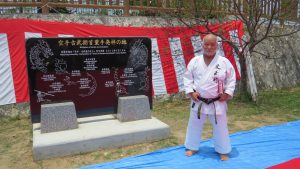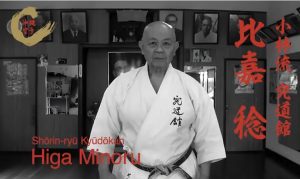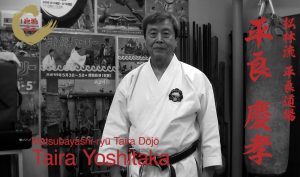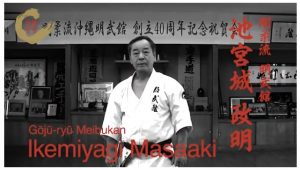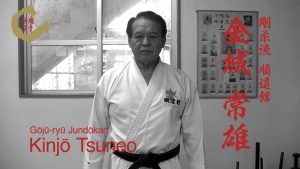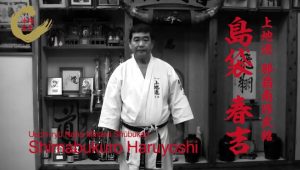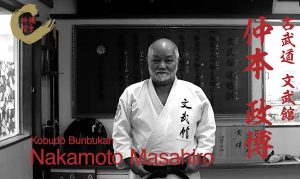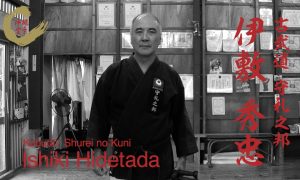Special feature articles
-
2024.06.13
"Kakuri (Hidden) Bushi," Jinsei Kamiya
-
2023.09.19
Karate Today - Yoshizato Hiroshi's Birth!
-
2023.08.29
Karate Today - Honolulu Karate Youth Club Found...
-
2023.08.15
Karate Today - Nakandakari’s Birth!
-
2023.08.03
Karate Today - Noma Seiji made his wedding in O...
-
2023.07.18
Karate Today - Yabu Kentsu conducts Karate prom...
-
2023.07.04
Karate Today - First "Karate Club" created for ...
-
2023.06.20
Karate Today - Yoshimura Chogi visited the form...
-
2023.06.06
Karate Today - Karate club at Prefectural First...
-
2023.05.26
Karate Today series will begin
-
2021.12.20
Martial arts demonstration in front of the king...
-
2021.03.08
Folktale: Why tigers can't climb trees
-
2020.12.22
About Rei – Part 2 by Nakamoto Masahiro
-
2020.11.17
Okinawa Karate "WA" Series
-
2020.10.05
About Rei – Part 1: Mabuni Kenei
-
2020.06.19
1969 article on master Yagi and Sūpārinpe
-
2020.05.22
1969 article on master Higa and Passai Dai
-
2020.05.08
1969 article on master Shimabukuro and Ānankū
-
2020.04.20
1969 article on master Kushi and Wankan
-
2020.04.14
1969 article on masters Kaneshima and Nagamine
-
2020.04.09
Article ”Even at 80 years old “Eyaa!” ” (Okinaw...
-
2020.04.09
Article ”Impressed with every move” (Ryūkyū Shi...
-
2019.12.03
Kobudō 9: Nakaima Kenkō and Uchima Anyū
-
2019.11.07
Kobudō 8: Kyan Shinei and Kaneshima Shinei
-
2019.10.29
Kobudō 7: Ishikawa Hōei and Higa Seitoku
-
2019.10.08
Kobudō 6: Nohara Kamaichi and Takara Shigeru
-
2019.09.13
About the estimated new photo of Itosu Ankō
-
2019.09.02
Karate policemen protecting the safety and secu...
-
2019.07.02
Kobudō 5: Soken Hōhan and Shiroma Taisei
-
2019.06.08
Kobudō 4: Kameshima Shinsuke and Chinen Masami
-
2019.06.01
Kobudō 3: Nakamura Shigeru and Higa Yūsuke
-
2019.05.24
Kobudō 2: Irei Matsutarō and Nakamura Heisaburō
-
2019.05.14
Kobudō 1: Kina Shōsei and Shinjō Heisaburō
-
2019.04.08
Questioning the weapons’ hunt
-
2019.01.21
Kyō Ahagon Jikki, the sword and karate
-
2018.05.04
The unveiling of the statue of Uechi Kanbun
-
2017.12.26
Following the steps of Matsumora Kōsaku
-
2017.10.20
Brushwork of late Matsumura Sōkon
-
2017.10.14
Maekawa bō performed at the Shihan Gakkō
-
2017.09.08
The declaration of the "Karate Day"
-
2017.08.15
A district connected to karate, Uebaru
-
2017.07.14
The beauty of Okinawa karate
While there are some anecdotes about Ryūkyū Kings and karate, like the ones relating to Matsumura Sōkon, martial arts related events mentioning specific areas of Shuri Castle are rare.
In 1866 was held the Sakuho ceremony of the last king of the Ryūkyū, Shō Tai. The following year, as the ceremony was completed successfully, a celebration was held at Uchaya Udun. Following the event, a karate and kobujutsu performance was held in front of the king in front of “Akata Ujō” gate.
(This event was introduced by curator Mrs. Sakihara Kyōko during a 2019 karate-related historic site tour. She also pinpointed that based on prewar records on Shuri Castle, the “Akata Ujō” gate originally referred to the “Bifukumon” gate and later the “Keiseimon” gate.)

To support this historical fact, the records “Tāfākū” of Kumemura - Kume Village mentions the program “Sanruchu Narabi Shogei Bangumi” which included martial arts demonstrations performed at the Uchaya Udun palace in Sakiyama in March 1867 and the later demonstration in front of the king.
Reference: “After proceeding according to the various programs and finishing by 7 o’clock, flagpoles were raised and a tug-of-war procession was formed in Kumemura in order to welcome the Sanruchu performers. Reaching Sakiyama Baba, the performers fully dressed joined in the procession to really create a Kumemura on parade. On the way back, they approached Akata Ujō where the king had hanged a script on the gate and was resting. Through the king’s envoy, the performers were asked to once again demonstrate their martial skills. As told, they performed 5 demonstrations in the street in front of the gate for the lord’s leisure. They then went back to Kumemura living from Tennōji, passing through the town and exiting from Shimo Ayajō (1).” (“Collection of writings of Shimabukuro Zenpatsu”, published in 1956.)
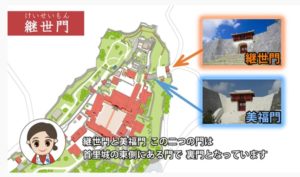
Keiseimon (upper photo in orange) and Bifukumon (lower image in blue)
These two gates are located on the east side of Shuri castle and are considered back gates.
(Source: Shuri Castle Guided Tour 12th episode “Keiseimon and Bifukumon” https://www.youtube.com/watch?v=3lHcdPHnm8I)
(1) Tennōji was a Rinzai sect temple during the Ryūkyū Kingdom era where the Shō queen was later enshrined. The site of the temple is located close to where the Shuri Church stands today, not far from Shuri Tonokura Post Office.
During the Ryūkyū Kingdom era, the road from Naha Port, the gateway to the sea, to Shuri Castle via Sogenji Temple in Tomari was the most famous public road in the kingdom. In particular, the wide road centered between “Shimo Ayajō” (another name for Chuzanmon gate– approximately where stand the store Shuri Ryusen next to Shuri Senior High School) and “Ui no Ayajō” (another name for Shureimon gate) was called “Ayajō Ufumichi”.
(Source: Naha City Museum of History, translation by OKIC)
The Okinawan folktale “Tora ga ki nobori no dekinai riyū” (Why tigers can't climb trees) can be found on the Hukumusume website (http://hukumusume.com/). We translated and present it below with the authorization of Hukumusume. Go there to listen to the original Japanese narration.
[audio mp3="https://okic.okinawa/wp-content/uploads/2021/03/WTTCT.mp3"][/audio]
Why tigers can't climb trees
Once upon a time, a tiger expert in Chinese martial arts came to Okinawa as he heard that Okinawa’s karate was powerful.
Arriving in an Okinawan town, the tiger spoke in an arrogant manner.
“I am a master of Chinese martial arts. It is a match between Chinese martial arts and karate to see which one is stronger!”
(silence)
“What's wrong? Are you fearing my Chinese martial arts?!”
(silence)
Having never seen such a big tiger before, the Okinawan animals are scared and no one tries to compete.
“If no one competes, Okinawa will be mine!”
At that moment, a small wildcat stepped forward in front of the tiger.
“Okay, I will take you on.”
This wildcat is an Okinawa karate master.
Looking at the wildcat less than his size, the tiger cackled.
“Gahahahaha. A little dwarf like you, challenging me? Okay, for you, just one throw. YAAHH!”
The tiger jumped at the wildcat, but as the wildcat dodges lightly the tiger's attack, he completely beat the large tiger.
“What? ... Not yet, it’s just the start!”
The tiger again aimed at a bout, but no matter how many times it tries, he is no match for the wildcat.
Admitting his loss, the tiger asked the wildcat joining both hands together.
“Master! Please, teach me your Okinawa karate!”
“Okay. Training is hard, but do your best.”
And so, the tiger was allowed to become a disciple of the wildcat and began to practice karate.
Having started karate, the tiger, who originally had a talent for martial arts, improved very fast.
Now that a year has passed, the tiger is the second karate expert after the wildcat.
Understanding the situation, the wildcat thought,
“At this pace, the tiger will become stronger than me. If it happens, one day, he may defeat me and rule Okinawa.”
And so, he didn't teach one of the many lethal techniques of karate.
One day, the bad premonition of the wildcat came true, and the tiger challenged the wildcat.
“Master. I became stronger than you. Now is the time to defeat you and rule Okinawa!”
“All right. I will do my best to defeat you and send you back to China.”
The karate skills of the tiger and the wildcat were equal, but as the tiger was originally advantaged as he excelled in Chinese martial arts, he gradually dominated the bout.
“Not good, if this goes on, I will lose…”
As he thought so, the wildcat used the special karate move that he did not teach the tiger.
That is, tree climbing.
As the wildcat lightly climbed the tree, he waited for the tiger from above.
“Hey master, are you escaping to such a place and surrender?”
The tiger chased the wildcat and also aimed at climbing the tree, but the tiger, who was not taught to climb trees, has a hard time to even cling to the tree.
“There is the chance!”
The wildcat slammed the immobile tiger clinging to the tree and sent him back to China.
And so it is. The tiger is a very strong animal who excels in Chinese martial arts and Okinawa karate, but as the wildcat didn't teach him to climb trees, he is said that he is still not good at climbing trees.
The end.
Bu “starts with Rei and ends with Rei”
If you put this in practice in your daily life, it will lead to the best of life. It is important to respect and esteem others. Regarding etiquette, “Rei” is not just about bowing. It is a form of prayer for the success and safety of a demonstration, a way of expressing gratitude to the past masters who devised the kata of martial arts, to the audience, to the performance venue (living thing that is the wood that forms the walls and atmosphere), to the weapons we use and to the people who are performing with us.
When you wake up every morning and say hello to your family, students, fellow students or teachers on their way to school, friends and acquaintances that you meet along the way, the other person will also reply. While living a social life, this leads to a smooth, calm and peaceful life.
“Shitsurei" (as in "excuse me” or a lack of gratitude) means to ignore the other party. "Kiri-sute gomen" - In the Edo period, there was a time when cutting down general commoners, tradesmen, and peasants who behaved rudely towards the samurai class would not be blamed. In all human relationships, the role of "respectful morale" is huge. Originally, the ultimate goal of Japanese martial arts resided in one point: "Uyamau (Kei)" meaning “respect”.
The old form for the character “Rei” has the meaning of offering sake to the gods. According to the Kadokawa dictionary on the origins of characters, there are: 1) Courtesy (Etiquette / Festival), 2) Ceremony (Dress code / Ceremony of proclamation of a Crown Prince), 3) How to show respect toward others (Rudeness / Impoliteness), 4) Gratitude; Expressing gratitude (Thank-you note / Remuneration) 5) Bow. Greetings (Worship / Eyes greetings) are mentioned among others.
When performing karate and kobudō, make sure to bow at the beginning and end of the performance. Bu or martial arts begins and ends with a bow, as a sign of courtesy and gratitude. We all have been strictly taught in this way. Rei is also a form of prayer that calms the heart, nurture a strong force and leads to realization. If you forget Rei, you will soon feel powerless. It is said that “A warrior dies for someone who knows him” (‘Historical records’). To know is to believe, and to always show gratitude should become a daily custom.
Okinawa Prefecture designated intangible cultural asset holder for “Okinawa Karate and Kobujutsu”
Chairman of the Okinawa Traditional Kobudō Preservation Society Bunbukan HDQRS.
Nakamoto Masahiro
82 years old
Many dōjō within the Okinawa prefecture have resumed their training. But in the midst of the Covid-19 pandemic, international karate enthusiasts still cannot visit Okinawa. In order to meet their demands, our information center has launched a new project titled “Okinawa Karate ‘WA’ Series”.
With the cooperation of instructors who have welcome and taught visiting karateka introduced by our center since its opening in 2017, we present you some videos showcasing the essence of Okinawa karate.
The title of the series, "WA" is usually understood as harmony. However, we chose a Japanese character meaning “to circulate, to surround, to go around,” with the hope that the martial art of Peace that is Okinawa karate will bring peace worldwide. "WA" is also an acronym for the words “Word” and “Action”, the concept on which this series is based.
Through this project, we hope to bring some encouragement to karate enthusiasts all over the world to keep training until they can come to Okinawa. We will update this page regularly, so please visit us frequently!
Shuri Tomari Te systems (Shōrin-ryū)
1. Kakie, Shōrin-ryū - Higa Minoru sensei
2. Gedan-barai, Matsubayashi-ryū - Taira Yoshitaka sensei
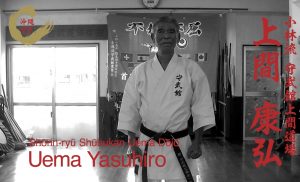
3. Itosu no Passai, Shōrin-ryū - Uema Yasuhiro sensei
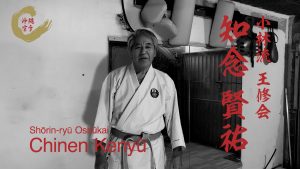
4. Pin-an Sandan, Shōrin-ryū - Chinen Kenyū
Naha Te (Gōjū-ryū)
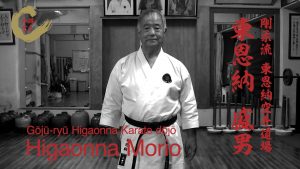
1. Kakie, Gōjū-ryū - Higaonna Morio sensei
2. Sanchin, Gōjū-ryū - Ikemiyagi Masaaki sensei
3. Sandan uke, Gōjū-ryū - Kinjō Tsuneo sensei
Uechi-ryū
1. Hojo undo (auxiliary exercise), Uechi-ryū - Shimabukuro Haruyoshi sensei
Kobudō
1. Nunchaku, Kobudō - Nakamoto Nasahiro sensei
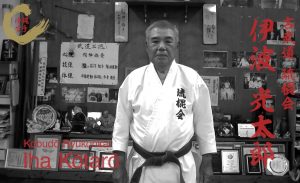
2. Bō-jutsu, Kobudō - Iha Kōtarō sensei
The article below written by Mabuni Kenei sensei, son of the founder of Shitō-ryū Mabuni Kenwa sensei, is part one of a series of two articles relating to Rei.
Rei can mean “to bow” as in “Shomen ni rei – Bow to the front”, but also translate as gratitude, etiquette and proprieties as in “Shurei mon”, the Gate of proprieties at the entrance of Shuri Castle.
Part two is an article written by Nakamoto Masahiro sensei, intangible cultural asset holder for Okinawa karate and kobudō as designated by the Okinawa Prefecture. (Coming soon)
(Photo courtesy from Mr. Sam Moledzki, President, Karate-do Shito-Kai Canada)
********
Mabuni Kenei
JKF Central Qualification Examiner
In all martial arts, sports, and in daily life, one of the most important things is “Rei.”
It is the same in karatedō. It is the most important matter, the first thing to be learned. Rei is not simply a formal lowering of the head, but a method of first correcting one's heart when facing someone, and then correcting one's posture to give a bow.
As for Rei, there is no problem for us Japanese people, but I was made to think about it by some foreigners.
At a dōjō in Central and South America, all the seniors and students lined up to perform Rei at the beginning of the lesson. As all of them were sitting upright in "Seiza", they prepared to bow on the command “Rei”. So far, it was very good but the essential aspect of "Rei" was wrong. All kept their hands on their knees and just knocked lightly their heads down. As all the students were enthusiastic and praiseworthy, I couldn’t understand what happened so I asked the seniors. I thus found out that the Japanese teacher who had been teaching before was so doing when being bowed to by the students. I think that if both the teacher and the learners had corrected their minds first, they would never have done this kind of bowing. (1)
Another episode that happened in another city. It was decided to hold a karate demonstration with the students of a university in this area. The venue, the gymnasium was soon overcrowded with the crowd that had come early. The space where we would perform was narrow, and the audience was only about two meters away from us. In the front row, women were sitting in chairs. If we sat in Seiza and “bow” toward the front as usual, it would inevitably be a respectful salute to the ladies. Somehow it didn’t seem correct. At that moment, I decided to stand in the front and executed a mutual bow with the students.
In the case of bowing, as a custom, I thought it should not be done as a formality. If needed, the method should be considered depending on the place.
In the demonstration of karatedō kata, there are also some movements that express Rei. These moves are aimed at warning against pride, and when performing in front of a large crowd, as our masters and seniors look upon our performances, we ask for their future guidance. The lessons of karate are "Karate ni sente nashi – There is no first attack in karate" and "Kunshi no ken – A gentleman’s fist”. These saying mean to train the fists and feet silently, to never hurt people and always treat people with a gentleman's attitude. In this way, the true purpose of karate is to cultivate a noble character and attitude by respecting etiquette.
Published in the Karate Shinbun Issue 93
Tenbōsha column
Publisher: Karate Shinbun Corporation
Date: March 20, 1977
Note:
(1) the proper way to execute Rei when kneeling:
From seiza (kneeling) with your hands on your thighs, facing the front of the dōjō, place first your left palm and then the right palm on the floor in front of you and then keeping your neck in alignment with your back bow. After a short pause, and after the instructor has completed his/her bow, raise again to the seiza position, retracting first your right hand and then your left placing them on your thighs.
